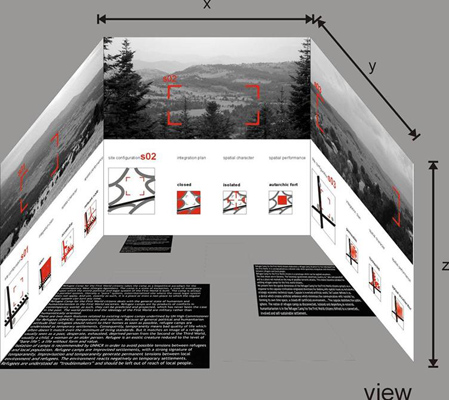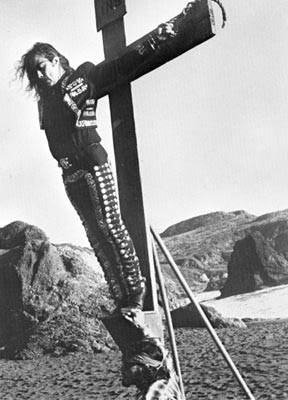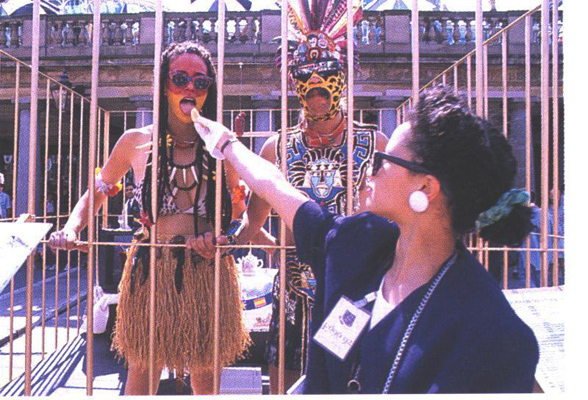Tomaž Toporišic on Emil Hrvatin and Peter Šenk
In the foreword to an issue of Janus magazine dedicated to notes on subversion, Jan Fabre and Henrik Tratsaert ask themselves one of the most frequently asked questions of the last decade:
“What strategies do artists, dramatists, performers, philosophers, scientists and others put into effect to undermine conventions, and to pervert and question society’s codes?”(“Dissident Voices / Notes on Subversion.” Janus 16.04, Antwerpen, 2004, 3.)
An answer may begin with Guillermo Gómez-Peña’s statement: “Each metier, language, genre and/or format demands a different set of strategies and methodologies.”(Gómez-Peña, “Navigating the Minefields of Utopia,” (A conversation with Lisa Wolford).” The Drama Review 46, 2 (T 174), New York, 2002, 73.) In the post-democratic world of global exchange, artists (and along with them theoreticians) have to adapt to the fact that the manifestations of power remain as risky as they were ten or twenty years ago. As a specific result, as well as an attempt of an artistic reply, they produce hybrid and fragmented forms of politicized art.
In Baudrillard’s transpolitical, transhistorical, and transeconomic post-millennial world, art returns to tactics and strategies of the political and politicized with less certainty about the possibility of its impact and with a stronger consciousness of the utopian and marginalized nature of its own being. Artists have to face the fact Herbert Blau describes in his book To All Appearances, Ideology and Performance: after the fall of the Iron Curtain and other events of the 1990s, “nothing recent in our given circumstances – from deconstruction to perestroika […] suggests that the situation of crises has in any way abated […]. At best we might be able to say […] that the situation of crisis has been put into the subjunctive.”(13.) However, after September 11th and the events that followed, we have to be dubious even about the subjunctive.
The performance activism and oppositional art of Guillermo Gómez-Peña’s La Pocha Nostra (2005) with its attempts at cross contamination, and Emil Hrvatin and Peter Šenk’s politicized anti-utopian project Refugee Camp for First World Citizens (2004) will serve as two examples of possible strategies of contemporary politicized art that – in the spirit of Mikhail Epstein and his theory of proto-formations in culture – could indicate a new politics of performing arts beyond the post-modern paradigm.
Their starting point is the awareness that, to quote Epstein, “the future is again advancing on us, not with an exclamation mark this time, but rather with a question to which there is not and cannot be a known answer.”(Epstein, After the Future: The Paradoxes of postmodernism and Contemporary Russian. Amherst: University of Massachusetts Press, 1995, 330.) In Hrvatin and Gómez-Peña’s projects, the first, the second, and the third world meet in the vague future of a common history of either refugee camps or immigrations.
Following Giorgio Agamben and his theory of the camp, Emil Hrvatin in his project takes the camp as a bio-political paradigm for the contemporary West. In his play of sliding signifiers, he reappropriates the Western or First World idea of the camp as a state of exception and explores in his artistic project the paradoxes of this parallel legal system he describes as “an exterritorialized site where the usual legal system does not apply. And yet, exactly as such, it is a place or even a non-place to which the regular legal system can turn any time.”(Emil Hrvatin and Peter Šenk, “Refugee camp for the first world citizens.” Janus. 16 / 04, Antwerpen, 2004. (77-79), 77.)
The origin for Hrvatin’s artistic intervention and the special tactics he employs when dealing with the lack of ethics and humanism in global contemporary society of the democratic First World is the hypothesis that refugee camps are by-products of conflicts in the contemporary world. They are also by-products of his assumption that “the world politics and the ideology of the First World are military rather than humanistically orientated.”(Ibid, 77.)
When understood as temporary settlements for the Second and Third world citizens, camps produce “a low quality of life that often does not even meet minimal living standards. But it matches the image of the refugee, usually seen as a poor, desperate, exhausted, deprived person …” According to UN policy, isolation of the camps is recommended in order to avoid possible tensions between refugees and local populations.
In the first part of their artistic project First World Camp, subtitled “a platform for artistic research into the demilitarisation of capsular societies,” Hrvatin and Šenk propose and elaborate a model of an anti-isolationist Refugee Camp for first-world citizens:a settlement that is ready to accept possible refugees from the First World.
Thus they invert the actual situation of existing refugee camps and develop what seems to be a utopian, yet very concrete proposal for a prototype that can be applied anywhere. They deliberately choose Slovenia, advertised by its government “as ‘safe and peaceful land’ ” a land that according to the same government “does not feature on the map of possible terrorist attacks.” They conclude their argument with a logical statement: “This makes Slovenia a suitable location for refugee camps for First World citizens.”(Ibid., 78.)
Hrvatin’s chosen platform for artistic research into the demilitarisation of capsular societies simulates the language of social sciences and politics in order to play with sliding signifiers and reappropriations of its logical reasoning. Hrvatin thus takes very seriously the role of spectacle that Guy Debord defines as follows:
“Understood in its totality, the spectacle is both the outcome and the goal of the dominant mode of production. It is not something added to the real world … On the contrary, it is the very hearth of society’s real unreality.”(Guy Debord, The Society of Spectacle. New York: Zone Books, 1994, 12-13.)
The artist is fully aware that “the real unity of the spectacle proclaims masks the class division on which the real unity of the capitalist mode of production is based. […] What creates society’s abstract power also creates its concrete unfreedom.”(Ibid.) Hrvatin aims to unmask this “unfreedom” with a simulation of the very language that ideology uses via the implication of the social science.
First World Camp deals with what Gómez-Peña describes as globalisation’s dark side. The fact that “entire third world countries have become sweatshops, quaint bordellos, and entertainment parks for the first World and for the inhabitants of the Southern Hemisphere the only options for participating in the ‘global’ economy are as passive consumers of ‘global’ trash, or providers of cheap labour or materia prima.”(Gómez-Peña, “The New Global Culture.” The Drama Review 45, 1, New York, 2001, 9-10.)
Hrvatin and Šenk are more than aware that the traditional boundaries between politics, culture, technology, finance, national security, and ecology are disappearing; therefore they construct a seemingly coherent and extremely elaborate system of configurations for refugee camps in the nearest future to come.
It is a kind of a humble project dedicated to the unstable future of the first world citizens after September 11th along with the development of events in Iraq. Thus they propose a concrete artistic answer to the question Richard Schechner asks in his book Performance Studies, an Introduction: “If a globalisation was treated as performance, what kind of performance would it be?”(227.)
Among various competitive scenarios, they choose one that is not very optimistic and undermines a postcolonial mimicry with its own humanitarian jargon. Hrvatin and Šenk are fully aware that extreme art has a problem, that using on-the-edge tactics of shock means they would have little left in their armoury that would remain shocking, and that every fetish imaginable has already been inscribed on the web.
Additionally, the artists are aware of a fact that Gómez-Peña acknowledges very often: that it is very difficult to find boundaries to push. This is the dilemma that every performance artist in the world is facing right now. Are there any margins left at a time when “gang members” are being utilised to publicise Nike and when in a few months Bin Laden could become “pop culture in Japanese anime”? Due to the fact that – according to Gómez-Peña once more – every possible outer limit has been commoditized in the mainstream, the question arises: Whom can artists shock any more? Is it their new role just to reflect on the very impossibility of transgression?
In his artistic work, Gómez-Peña has used a variety of shock techniques: in a 1994 event, he and Roberto Sifuentes crucified themselves in front of San Francisco’s Golden Gate Bridge to protest against the “xenophobic immigration policies” of then-California governor Pete Wilson.
In 1992-93, in response to the many mainstream celebrations of the 500th anniversary of Christopher Columbus’s “discovery” of the “New World”, he and Coco Fusco staged a performance that parodied the display of exotic people by and to Europeans and Euro Americans. The artists lived for three days in a golden cage on Madrid’s Columbus Plaza, disguised as recently-discovered “primitive” Amerindians from an island in the Gulf of Mexico. The exhibit was seen also in London, Sydney, in several locations in the US, and in Buenos Aires.
As “Guatinauis,” they carried on their lives under the gaze of spectators, even dancing to rap music for small donations. Two guards led them on leashes to the toilet. Many persons were aware that this was in fact a politically savvy performance, but a surprising number were not.
There are some evident similarities in the artistic strategies employed by Gómez-Peña and Hrvatin-Šenk. Both subvert the already-blurred boundaries between art and politics. Gómez-Peña’s newly discovered Amerindians exposed uncomfortable parallels between international arts festivals, colonial expositions, museum displays and tourist expeditions. The project created a parallel world of art, commenting on the state of ethics in post-colonial society. It also performed the task of a living artistic situation commenting on the impossibilities of a straightforward political art as means of revolutionizing and the vices of a changing global society.
Hrvatin and Šenk share with La Pocha Nostra a common denominator: “the desire to cross and erase dangerous borders including those between art and politics […] ultimately to dissolve borders and myths of purity.”(Gómez-Peña, “The performance activism and oppositional art of La Pocha Nostra”. Janus. 16 / 04, Antwerpen, 2004. (53-57), 53.) But this desire uses tactics of the political that differ from those of La Pocha Nostra. They dissolve borders between politics and art by using politics as a basic field for their artistic research that is very difficult to interpret by means of any identifiable aesthetics.
Instead of developing an aesthetics of their own (Gómez-Peña’s case defined his aesthetic as a “robo-baroque” or an “ethno-techno-cannibal aesthetic”), Hrvatin and Šenk pretend to research the politics and aesthetics of a specific by-product of the postmillennial global world: that of refugee camps for citizens of the Third World.
More than this, the politics of art they employ are the very tactics of UNHCR, NATO, and other trans-national organisms of the so-called “humanitarian” powers. Their persuasion (which is linked to ideas by Agamben) is that phenomena such as refugee camps are moving to center stage in today’s society.
If Epstein, commenting on contemporary society, writes that “the future emerges as a soft form of negativity, as a vagueness within any sign, or diffuseness of any meaning,”(Epstein, 335.) then Hrvatin and Senk give this soft, vague form of negativity a clear and organized image. By using their Refugee Camps for First World Citizens as paradigms for the contemporary West, they counter the classical notion that art creates a parallel world with the statement that “a camp is always a parallel system, literally a ‘para’-system.”
The analytical approach to contemporary political reality the artists apply in their project bears certain similarities to Mikhail Epstein’s analysis of post-communist Russia where “post communism [is] rapidly moving into the past, on the very heels of communism.”(335.)
The artists agree with Epstein that “there is a need to go beyond the confines of both Utopia and its resonating parodies. The post-communist epoch can count only a few years to its name, having suddenly bogged down in the protoplasm of some new, unknown social system.”(Ibid, 330.) The question raised by Epstein’s statement about contemporary Russia can easily be applied to the global situation after the fall of the Berlin wall, the end of the cold war, Afghanistan, September 11th, and recent events in Iraq.
Hrvatin/Šenk seem to be proposing that we live in a new era of a new, unknown social system. This era can be defined as post-democratic, post-racial, or, to use Agamben’s terms (from The Face), “a global civil war, whose battlefield is social life in its entirety, whose storm troopers are the media, whose victims are all the peoples of the Earth.”(Giorgio Agamben, “What is a Camp?” Means Without Ends: Notes on Politics. Trans. Vincenzo Binetti and Cesare Casarino. Minneapolis: University of Minnesota Press, 2000, 99.) As communism and the cold war are left behind, “the future has been cleansed of yet another spectre, or idol, and such cleansing, or demythologisation, of time is the proper function of the future.”(Epstein, 335.)
In the First World Camp project the future advances on us, “not with an exclamation mark this time, but rather with a question.” In this respect, Hrvatin’s and Senk’s project relates to Giorgio Agamben’s concept of the camp “not as a historical fact and an anomaly that […] belongs to the past, but rather in some sense as the hidden matrix and nomos of the political space in which we still live.”(Agamben, 39.)
Following Agamben we could argue that the Camp project is based on the idea that the sovereign power of the camp is founded on the ability to decide on what constitutes an exceptional state. Therefore, the camp is the structure where such a state of exception is permanently realized. The artists start from the assumption Slavoj Žižek makes in his comments on the new American and global attitude to prisoners of war and immigrants: “Today as a term denoting exclusion, homo sacer, can be seen to apply not only to terrorists but to those who are on the receiving end of humanitarian aid (Rwandans, Bosnians, Afghans), as well as to the sans papiers in France and the inhabitants of the favelas in Brazil, in the African American ghettoes in the US.”(Žižek, Slavoj. “Are we in a war? Do we have an enemy?” London Review of Books 24.10 (23 May 2002).)
With its proposal to invert this fact, the Camp project undermines the state of exception and together with this the entire bio-political paradigm of the contemporary West. By proposing a refugee camp for individuals from the First World that encourages interaction between refugees and local people, Hrvatin’s and Senk’s project ex negativo also addresses the bio-political paradigm of the camp that Agamben defined in the following statement:
“Inasmuch as its inhabitants have been stripped of every political status end reduced completely to naked life, the camp is also the most absolutely biopolitical space that has ever been realized – a space in which power confronts nothing other than pure biological life without any mediation. The camp is the paradigm itself of political space at the point in which politics becomes biopolitics and the homo sacer becomes indistinguishable from the citizen.”(Ibid., 40.)
Hrvatin and Šenk’s project reflects this specificity and models a new reality of a refugee camp, interpreted (alongside Agamben) as the very model that replaces the city as the fundamental bio-political paradigm in the First World. The artists want to explore this paradigm further in a number of projects in different European regions in 2005 and 2006:
• A ship as a refugee camp (Venice and Rotterdam) uses boats as temporary refugee camps, a kind of modern ‘stultifera navis’ that nobody wants to accept or pay attention to. These refugee camps would be placed in exterritorial seas and would move from one spot to another.
• The train as a refugee camp (Žilina, Slovakia) uses a train as the main vehicle for the transportation of civilians to concentration camps.
• A former US military base serving as a refugee camp. The German town of Giessen becomes the place where refugees from ex-communist countries are be temporary settled. Due to the loss, in 2007. of a US military installation the city of Giessen will be left with 700 apartments. The focus of this project is the transformation of a military base into a refugee camp.
• A hotel as a refugee camp (Slovenian/Croatian coast).
• A museum as a refugee camp (Vienna). This project uses the Museumsquartier Kunsthistorisches Museum, and Naturhistorishes Museum as possible refugee camps, exploring the function of a museum in a war situation, alongside the possible reactions of the refugee.
With partners from several European countries and regions, Hrvatin and Šenk propose to construct a new paradigm of camps not as factories of death but, as Hannah Arendt put it, as a mode of life “outside of life and death.” They are proposing this “mode of life” as a Noah’s Ark of the post-September 11th, 21st-century bio-political situation.
As with Gómez-Peña’s performance activism, it is a little hard to imagine how the politics that the Hrvatin and Šenk’s project might produce will serve as a real alternative to those which it contests. But is this not also the case with most of today’s subversive approaches to art? Was this not true also for the post-modern, post-socialist politicized art in the Second World Countries? And was this not the case with the trans-, neo- and historical avant-gardes; political theatre of the 70s, 60s, and 50s; politicized art of the 1990s and 1980s? Fabre’s question which I quoted initially seems to lead us to nothing more than a new series of questions.







